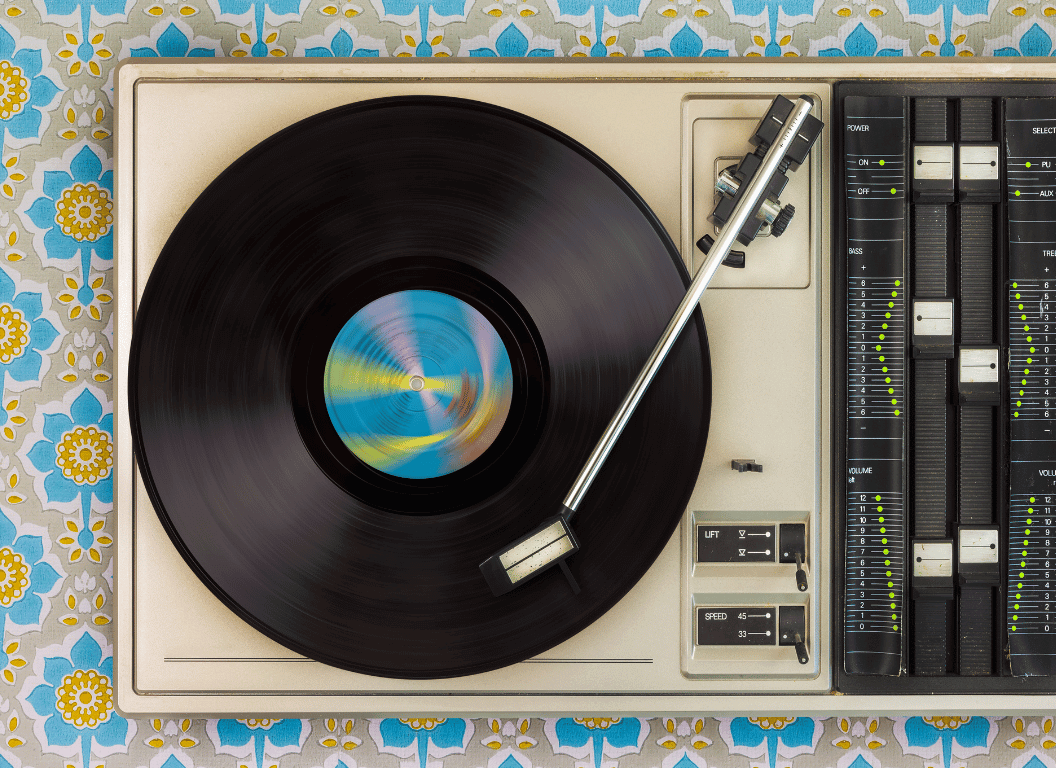In the world of music production, the lo-fi hip hop genre has grown exponentially, becoming hugely popular among listeners and creators alike.
This surge can be attributed to the genre’s unique allure, which often stirs feelings of nostalgia, relaxation, and introspection.
Embracing the essence of ‘less is more’, many producers find interest in crafting these ambient soundscapes.
The backbone to these hypnotic tunes often lies in the chord progressions.
In this article, we’ll be delving into some examples of these chord structures, providing producers a guide to help sculpt their very own lo-fi beats.
With this knowledge, producers can create captivating soundtracks that resonate, leaving an imprint on the growing lo-fi landscape.
Table of Contents
- Lo-fi Chord Progressions
- II-V-I (2-5-1)
- I-V-vi-IV (1-5-6-4)
- I-iii-IV-ii (1-3-4-2)
- I-IV-V (1-4-5)
- I-vi-iii-vii° (1-6-3-7)
- VI-v-iv-III (6-5-4-3)
- I-vii°-vi-V (1-7-6-5)
- ii-V-I-IV (2-5-1-4)
- I-IV-vi-V (1-4-6-5)
- I-IV-vii°-iii (1-4-7-3)
- ii-vi-IV-I (2-6-4-1)
- I-vi-ii-V (1-6-2-5)
- I-ii-vii°-IV (1-2-7-4)
- vi-IV-I-V (6-4-1-5)
- ii-IV-I-V (2-4-1-5)
- vi-ii-V-I (6-2-5-1)
- IV-I-vi-vi (4-1-6-6)
- The Bottom Line
Lo-fi Chord Progressions
II-V-I (2-5-1)
Dominant force in Jazz, the II-V-I adds soulful nostalgia to beats.
The II-V-I (2-5-1) progression is a fundamental chord sequence prevalent in a variety of music genres, especially jazz and lo-fi, offering a harmonic foundation to create a mellow and nostalgic tone. It provides smooth transitions and unexpected turns, which gives depth to the rhythm, making it an ideal choice for producers looking to incorporate a vintage vibe into their beats.
- Difficulty: Easy
- Example: Am – D – G (Key of G major)
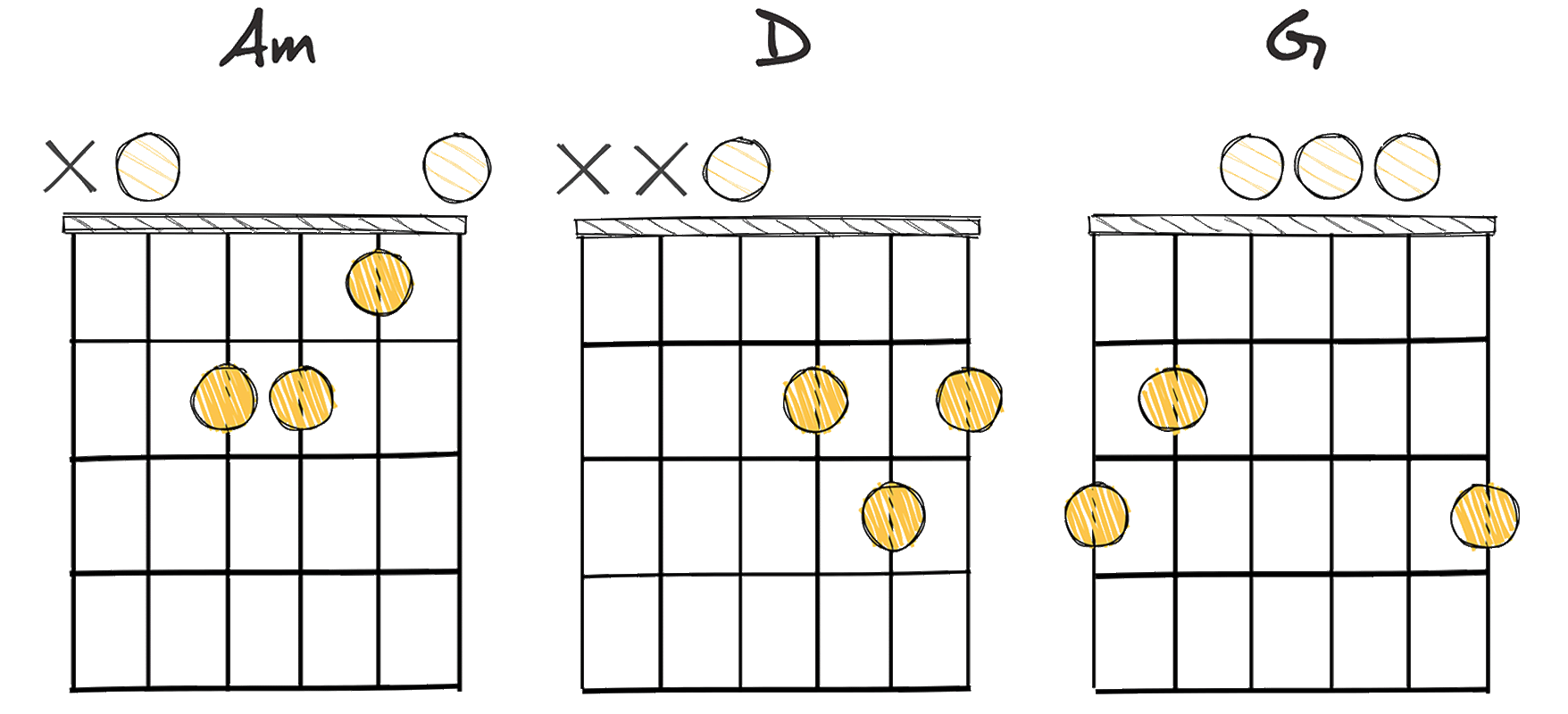
The II-V-I (2-5-1) chord progression is a fundamental pillar within the world of music, particularly within the genres such as jazz and now, lo-fi.
This progression has been revered time and again for its melodic strength and harmonious consistency.
Originating from the classical music of European origin, the II-V-I chord progression carries a rich history with its usage dating back centuries.
It has contributed significantly to Western music’s harmonic language.
Such is the historical significance of the 2-5-1 chord progression, that it transcended to Jazz in the 20th century, frequenting ballads and songs, and eventually found its way into modern musical forms like lo-fi.
Interestingly, II-V-I is known for its melodious simplicity, which has truthfully made it a popular choice amongst composers, songwriters, and producers.
The simplicity of the II-V-I chord progression allows for a smooth flowing harmony, and at the same time, provides a grounding bass part for easy playability.
This feature has extended this chord progression’s usage beyond complex musical forms like jazz, into simpler, more accessible genres like lo-fi.
One of the defining attributes of the II-V-I chord progression is its beautiful resolution, which lies in the progression’s ability to always lead back to the tonal center.
Such quality of tonal centering not only helps establish a clear melody but also offers a comforting sense of resolution to the chords.
This attributes to the progression’s wide usage, with lo-fi being no exception.
In fact, the II-V-I progression’s harmonic resolution is often used in lo-fi to evoke feelings of nostalgia and wistful reflection, which are characteristics intrinsic to the lo-fi genre.
It methodically orchestrates the chords, creating an easily recognizable melody while providing a strong underlying bass part.
Thus, for lo-fi music producers, understanding and incorporating the II-V-I chord progression can prove to be very advantageous as it provides a user-friendly approach to creating beats with emotional depth and musical richness.
I-V-vi-IV (1-5-6-4)
A soulful harmony perfect for injecting melancholy into lo-fi beats.
The I-V-vi-IV chord progression is a popular sequence extensively used in music production for its emotive and catchy appeal. Its smooth transition from the tonic to dominant to submediant and subdominant creates a memorable yet sonically pleasing rhythm, making it a great choice for lo-fi beats and moodier tracks.
- Difficulty: Easy
- Example: C – G – Am – F (Key of C major)
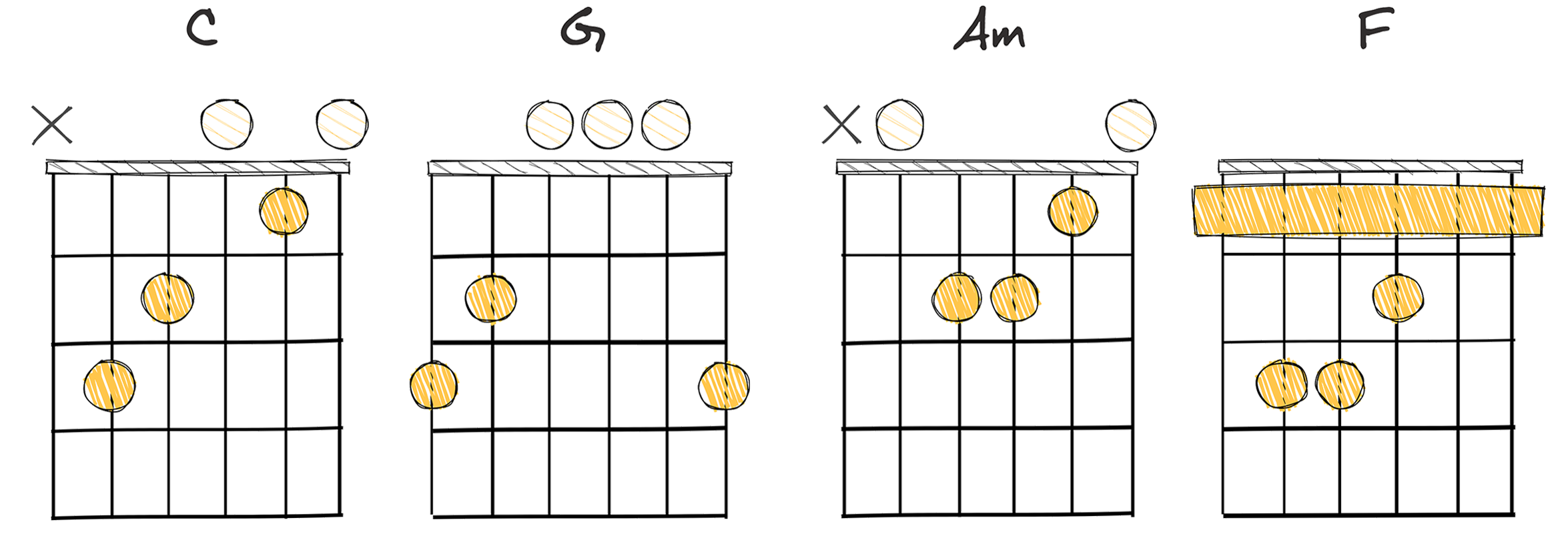
The I-V-vi-IV (1-5-6-4) chord progression is a series of chords that is ubiquitous in lo-fi music production.
This progression is considered as an easy chord progression to play, making it a go-to choice for many lo-fi beat producers looking to create a mood-filled sonic experience.
The I-V-vi-IV has a rich history in the music world and its origins date back to classical music, but it has become a staple in modern pop, rock, and especially lo-fi music genres.
Integral to this progression’s success is its innate ability to create mood and atmosphere.
One of the key features of the I-V-vi-IV progression is its innate musicality that brings out the emotionality of the song’s theme while drawing the listener in with its hypnotic rhythm.
This compelling rhythm, paired with its simplicity, makes for an enticing canvas for a variety of melodies and sound textures, all key components in lo-fi beats.
The I-V-vi-IV progression also opens up a vast world of creative possibilities and experimentation, allowing producers to tweak and play around with different sounds to achieve their desired aesthetic.
Even as an easy-to-play chord progression, the I-V-vi-IV holds a significant place in music history and remains a crucial tool for today’s lo-fi beat producers.
Its versatility and musicality offer an array of options for lo-fi beat producers, allowing them to create textured tracks that resonate with listeners.
Ultimately, the I-V-vi-IV progression is not only a staple in lo-fi music production but an instrument within itself that has the power to evoke a range of emotions, from nostalgia to relaxation.
I-iii-IV-ii (1-3-4-2)
Exudes a reflective and soothing melody, creating an introspective ambiance ideal for Lo-Fi music.
The I-iii-IV-ii progression in C major (C – Em – F – Dm) emanates a calming and contemplative ambiance. Its gentle blend of major and minor chords creates a reflective, soothing melody, inviting the listener into a serene musical journey. The progression is synonymous with introspection, making it a favorite in Lo-Fi music.
- Difficulty: Easy
- Example: C – Em – F – Dm (Key of C major)
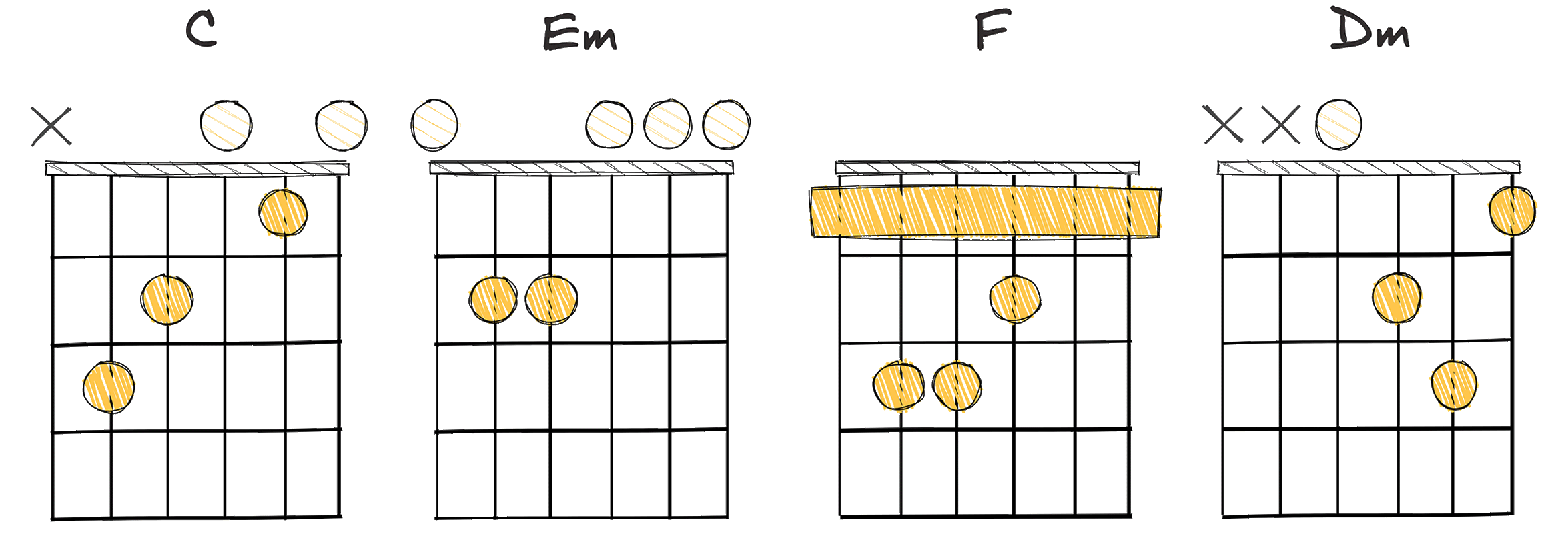
When diving further into lo-fi chord progressions, the I-iii-IV-ii (1-3-4-2) progression carves a distinctive niche, offering a gentle, contemplative touch to your beats.
Unfolding a detailed look at this progression, it is clear that many producers have found it an instrumental tool in evoking a laid-back, introspective ambiance typical in Lo-Fi music.
The I-iii-IV-ii progression, also known as the 1-3-4-2 progression, is frequently linked with a calming, reflective tone.
This can be an essential tool for producers who are crafting a looser, more relaxed sound, characteristic of the Lo-Fi genre.
In this progression, the blend of major and minor chords helps to create a thoughtful, wandering atmosphere right from the start.
This chord progression has been explored in various Lo-Fi tracks, reaffirming its stature as a favored selection for producers seeking a chill vibe.
These smooth, repetitive chord sequences invoke a serene emotional response, showcasing the substantial potential of the I-iii-IV-ii progression.
Continual use of the progression can craft a soothing rhythm that captivates listeners, inviting them into a tranquil musical landscape.
Though not as ancient as some other progressions, the I-iii-IV-ii sequence has found its place in modern chilled music, especially in Lo-Fi.
Particularly within the Lo-Fi community, this progression has become a cherished ingredient, renowned for its gentle play and soul-soothing sound.
Moving on to the progression in the key of C major, we have the chords C – Em – F – Dm.
This chord progression offers a cool, introspective timbre that can stand as the soul of many Lo-Fi compositions.
Here, the 1-3-4-2 progression supplies an unpretentious yet resonant harmonic framework, underlining the song’s pensive narrative.
Speaking purely from a technical standpoint, this progression is quite approachable, making it an appealing choice among Lo-Fi enthusiasts and budding musicians.
The use of both minor and major chords in this progression allows a rich exploration of emotions, establishing it as a versatile tool in a producer’s toolkit.
The allure with the I-iii-IV-ii progression resides in its harmonious combination of ease and profundity.
While the four-chord sequence may seem elementary, the emotional depth it can evoke is abundant and resonating, making the progression a fascinating one to delve into for any Lo-Fi producer or musician.
The I-iii-IV-ii progression is an invaluable asset in shaping various moods and textures in Lo-Fi music.
I-IV-V (1-4-5)
Embrace simplicity and nostalgia with this fundamental lo-fi progression.
The I-IV-V chord progression, commonly known as the “1-4-5”, is a fundamental sequence used extensively in the Lo-Fi genre, popular for its simplicity and harmonic resonance. Given its inherent versatility, producers often employ this progression to help construct an underlying rhythm and musical structure for their beats.
- Difficulty: Easy
- Example: G – C – D (Key of G major)
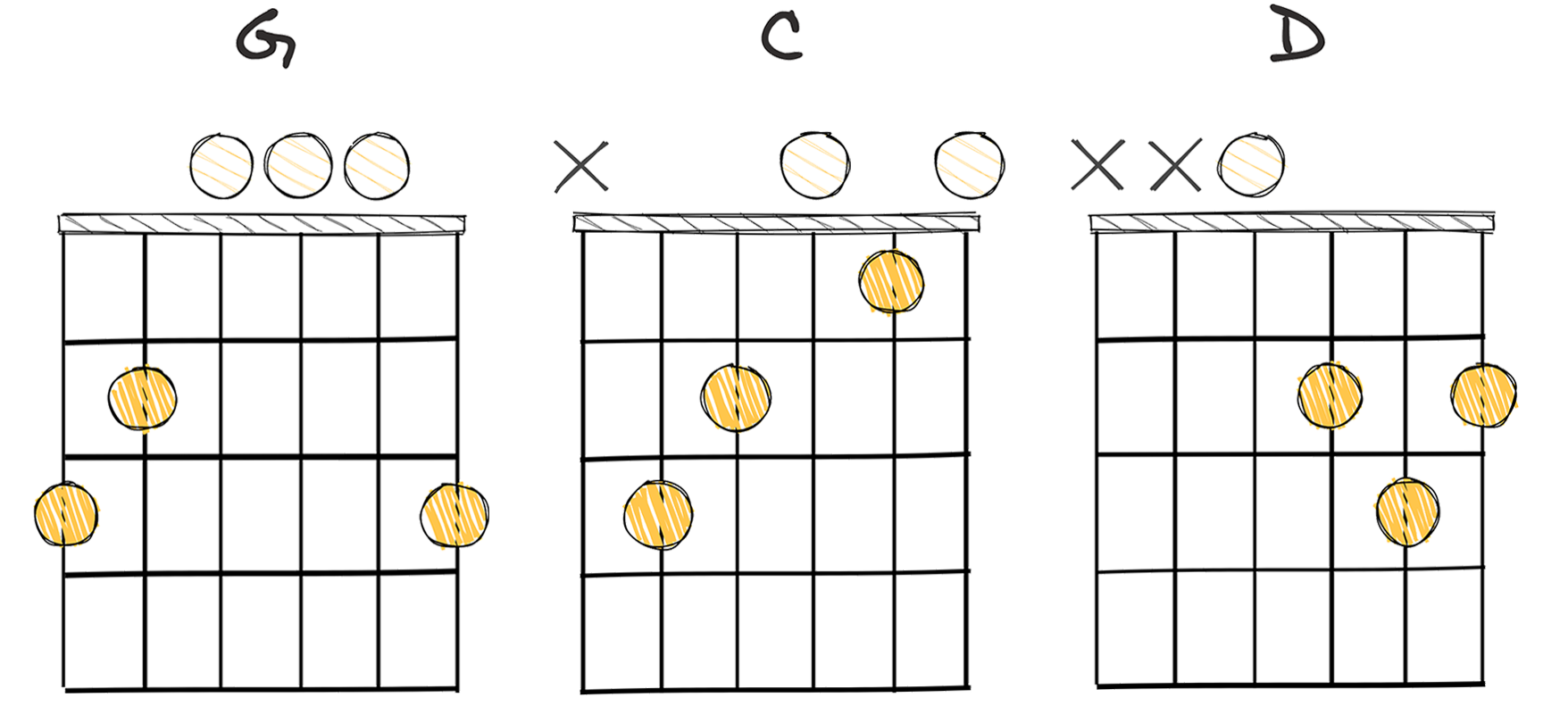
The I-IV-V chord progression is a staple in the realm of lo-fi music production, hence its inclusion in this list of Lo-Fi Chord Progressions For Producers To Use In Beats.
The beauty of this progression lies in its simplicity.
Using only three basic chords, it grants the producer a broad scope to experiment with different melodies and rhythm patterns.
The simplicity of the I-IV-V makes it particularly appealing for beginners or for those who want to create a beat quickly.
This is due its ease of use on various instruments, most notably the piano and guitar.
The simplicity and ease of the I-IV-V progression make it a favorite among novice musicians and producers, providing a solid foundation for musical experimentation.
Supported by the progression’s innate ability to guide a song to a satisfying resolution, it allows for smooth transitions between the I, IV, and V chords, creating a loop of rising and falling tension that lightly pushes a track forward.
This dynamic element is key in lo-fi music, where a beat might repeat for several minutes with minor variations.
This demonstrates the progression’s historical use in creating popular tunes that can captivate a wide range of audiences.
In addition, the repetitiveness and plainness of this chord progression create a unique possibility for music makers to blend various music styles and elements into their sound.
This emergent flexibility leaves plenty of room for creative experimentation within the boundaries of these three chords.
Despite its simplicity, the I-IV-V progression has a timeless quality that has made it a staple in various genres of music, not just in Lo-Fi. Its versatility gives it the ability to adapt to any beat or rhythm infused by the producer, proving its value in music production.
The simplicity and accessibility of the I-IV-V in multiple genres, particularly in the world of lo-fi, make it one of the essential chord progressions every producer should have in their toolkit.
The ongoing use of this progression in the creation of iconic beats guarantees its importance in the present and future of lo-fi music production.
I-vi-iii-vii° (1-6-3-7)
Imbued with nostalgic vibes, perfect for compelling and reflective beats.
This I-vi-iii-vii° (1-6-3-7) chord progression, popular in Lo-Fi music, is known for its melancholic yet soothing vibe and it’s versatility. It embodies a unique blend of minor and major chords, creating a mix of tonal shifts which contribute to its characteristic chill, nostalgic, melancholic feel, making it a favorite choice for beat producers.
- Difficulty: Intermediate
- Example: C – Am – Em – Bdim (Key of C Major)
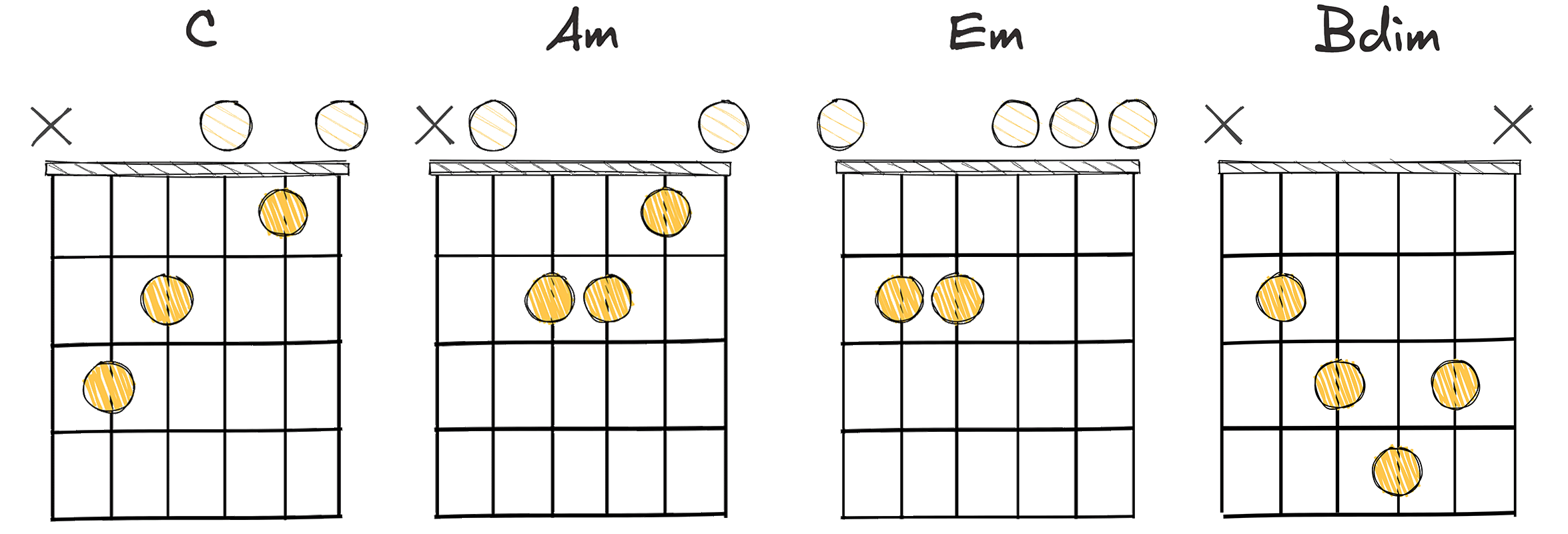
The I-vi-iii-vii° (1-6-3-7) chord progression is one that is integral to the lo-fi genre, and helpful for any beat producer who wants to create a more relaxed and downtempo ambiance in their music.
This chord progression, also known as the “Creep” progression due to its famous application in Radiohead’s iconic song, is known for its meditative sadness, perfect for achieving the introspective, pensive tones that define lo-fi beats.
In music theory, this progression has its roots in the traditional harmony of the minor key, with the chord built on the first scale degree (I) serving as the tonal center.
The role of the vi chord, or the sixth scale degree, often adds a deep level of emotional resonance to the progression, creating a sense of longing or nostalgia.
Then, the progression moves to the III or third scale degree, introducing an unexpected tonal shift that can be a powerful tool for the producer in manipulating the listener’s emotional response.
This tonal shift can be used to add an element of surprise in the beat, keeping the listener engaged throughout the song.
Moreover, the final chord of the progression, VII, often creates a satisfying resolution, rounding out the previous chords and bringing the progression full circle.
This thoughtful arrangement of chords can create a distinctive, haunting mood throughout a lo-fi beat, making the i-vi-III-VII an indispensable tool in the beat producer’s repertoire.
Playing these chords can be a bit intermediate, requiring some familiarity with chord progressions and finger positioning.
Take, for instance, the chords C – Am – Em – Bdim in the key of C Major.
The progression starts off, naturally, with the first scale degree, C, serving as the home chord, or ‘I’.
The next chord, vi, is represented by A minor, adding a somber tone to the progression right off the bat.
Em is the iii chord in this progression, providing an unexpected twist and making the progression even more interesting.
In the context of lo-fi music production, this progression might be looped throughout a track, providing a solid foundation upon which the producer can layer additional musical elements, such as drums, bass, and sampled vocals.
Obtaining a clear grasp of this progression and how it impacts the overall tone of a song can be a stepping stone for aspiring lo-fi music producers to experiment and discover their unique sound.
VI-v-iv-III (6-5-4-3)
Chill, introspective progression perfect for crafting vintage sonic landscapes.
This chord progression, VI-v-iv-III, is popularly employed in lo-fi music genres, offering a melancholic and nostalgic resonance that complements the genre’s signature low fidelity sound. Rooted in a minor tonality, it provides a harmonic basis that can imbue a wash of emotive textures into your beats, perfect for creating that iconic chill, lo-fi vibe.
- Difficulty: Easy
- Example: F – Em – Dm – C (Key of A minor)
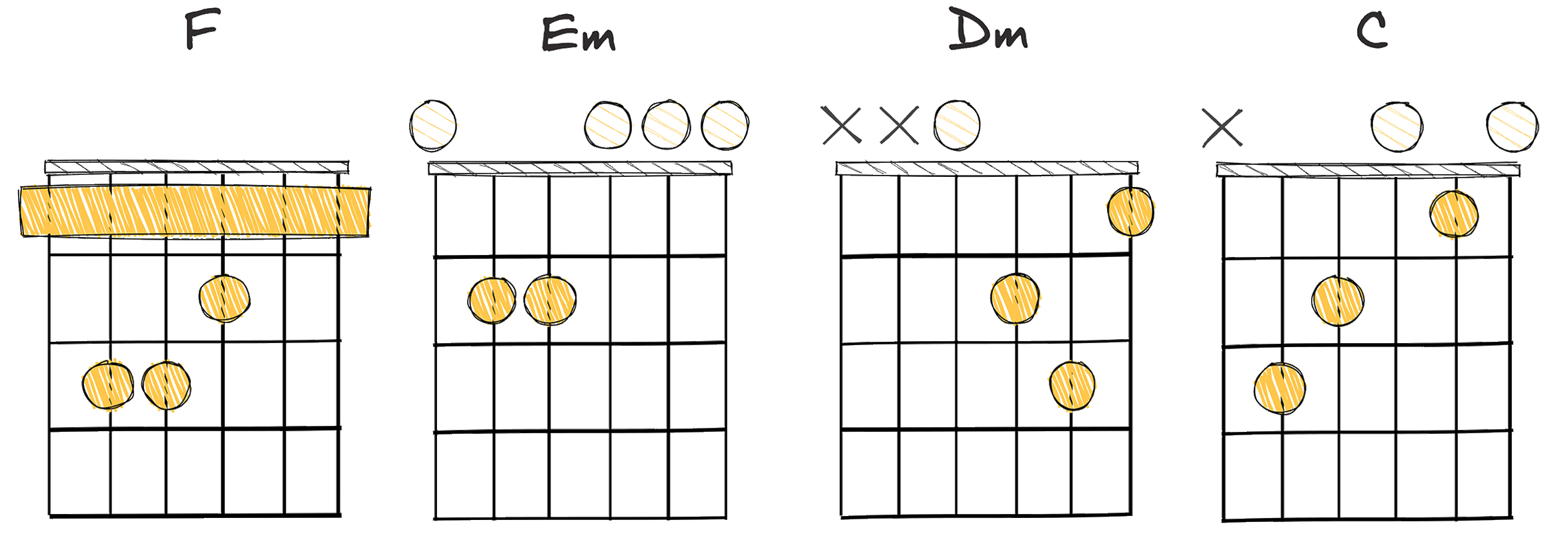
The VI-v-iv-III (6-5-4-3) chord progression is an interesting progression that has been used in a variety of musical genres, from pop to jazz, rock to R&B, and of course, lo-fi music.
This particular progression can produce a melancholic tone, creating an emotional resonance that is often sought after in lo-fi and downtempo music.
In the key of A minor, which is a common key for lo-fi music, the chords in this progression would be F – Em – Dm – C.
These chords, when paired together, produce a beautiful and haunting melody that can stir the emotions of the listener.
The transitional movement from the vi chord to the V, then to the IV, and finally the III, creates a smooth descending progression that is easy on the ears and easy to play for producers.
This chord progression has been featured in numerous tracks across various genres.
While the VI-v-iv-III chord progression can seem easy to play, due to the relative simplicity of the chords involved and their proximity on a keyboard or guitar fretboard, it can also provide a deep well of creative potential for producers.
Lo-fi music, with its emphasis on mood and atmosphere, makes it an ideal style for employing this chord progression.
The key is to experiment with different rhythms, textures, and harmonic variations within the progression to create a sound that is unique and evocative.
The history of VI-v-iv-III progression extends far back in time, spanning across various eras and genres of music.
Its ability to invoke a powerful emotional response from listeners has made it a favorite choice for composers and musicians alike.
The chord progression’s relative simplicity has also added to its popularity, because it allows musicians to focus more on the emotion of the piece rather than the complexity of the arrangement.
This progression’s enduring appeal is a testament to the power of well-chosen chord progressions and their ability to breathe life into a composition.
I-vii°-vi-V (1-7-6-5)
This iconic progression crafts a sophisticated, haunting beauty, weaving tension and emotion, a sound embraced in lo-fi music.
The I-vii°-vi-V progression in E major (E – D#dim – C#m – B) produces an alluring and sophisticated sound. The diminished chord introduces an element of tension and intrigue, while the subsequent transitions to minor and major chords create an emotional resonance. This progression has a haunting beauty, particularly resonant in lo-fi music.
- Difficulty: Easy
- Example: E – D#dim – C# – B (Key of E major)
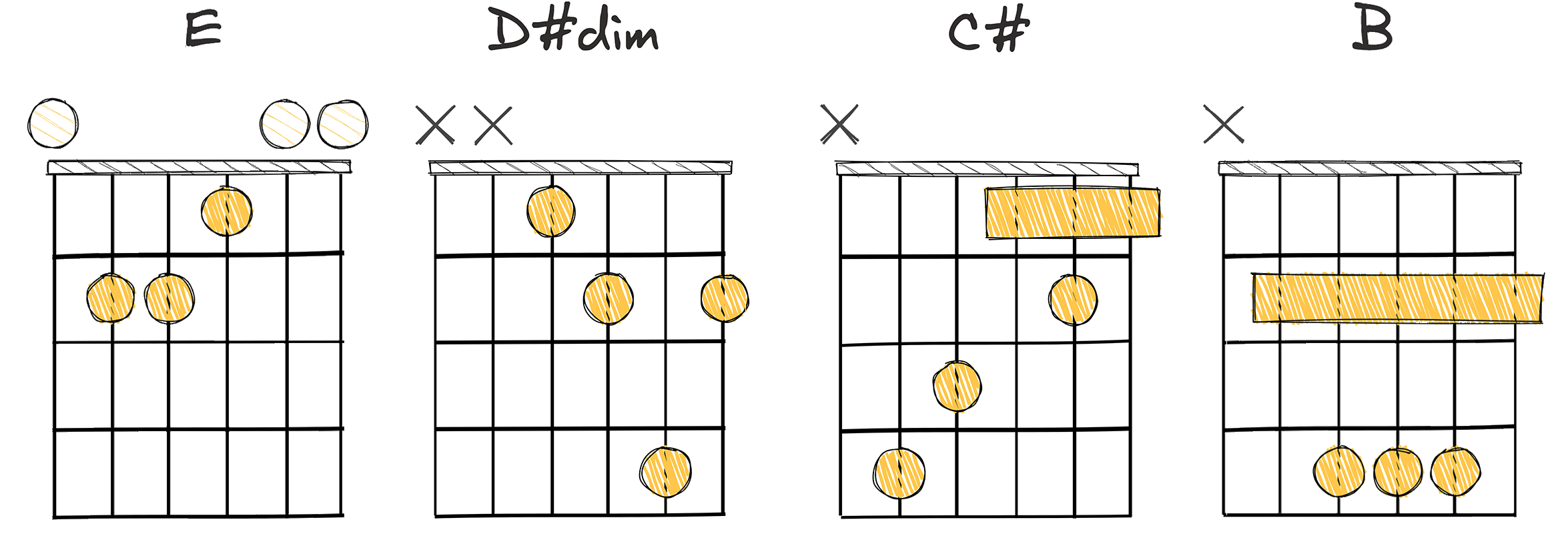
The I-vii°-vi-V (1-7-6-5) progression is a distinguished and evocative chord progression in lo-fi music and can be found in various other genres as well.
While not as conventional as some progressions, it has been explored by innovative artists and producers for its intriguing complexity and emotional resonance.
Artists and producers find allure in this progression, as it provides a rich canvas that fits seamlessly into many musical styles, especially lo-fi.
The distinct combination of a diminished chord with major and minor chords opens up an expansive palette of soundscapes within the lo-fi genre, offering an array of expressive possibilities.
The I-vii°-vi-V progression’s appeal also lies in its capacity to stir profound emotional reactions through its hauntingly beautiful and sophisticated chord transitions.
Despite its somewhat more complex structure, it is becoming a more prevalent choice among lo-fi producers for its exceptional ability to infuse a track with both mystery and depth.
In exploring the lineage of the I-vii°-vi-V sequence, one can discover its growing presence not just confined to lo-fi but resonating across various musical landscapes.
Its unique blend of chords lends it a distinct flavor that transcends traditional genre boundaries, adding to its contemporary charm and eclectic quality.
Furthermore, mastering and utilizing this progression can elevate musicians’ understanding of musical intricacies and chord interplay, enhancing the richness of their creativity even within the understated realm of lo-fi.
In the context of E major, the chords E – D#dim – C#m – B encapsulate this progression’s mystique, embodying a sound that is at once familiar yet alluringly different, making it an exciting exploration for those engaged in the art of lo-fi music production.
ii-V-I-IV (2-5-1-4)
Perfect for creating chill, nostalgic vibes in your Lo-Fi beats.
The ii-V-I-IV chord progression is a vital harmonic sequence widely utilized in many styles like jazz, pop, and classical music, giving beats a soothing, timeless vibe. Its popularity lies in its tonal stability and resolution, making it an excellent base for creating catchy melodies and providing a foundation for complex improvisations in Lo-Fi music production.
- Difficulty: Intermediate
- Example: Dm – G – C – F (Key of C major)
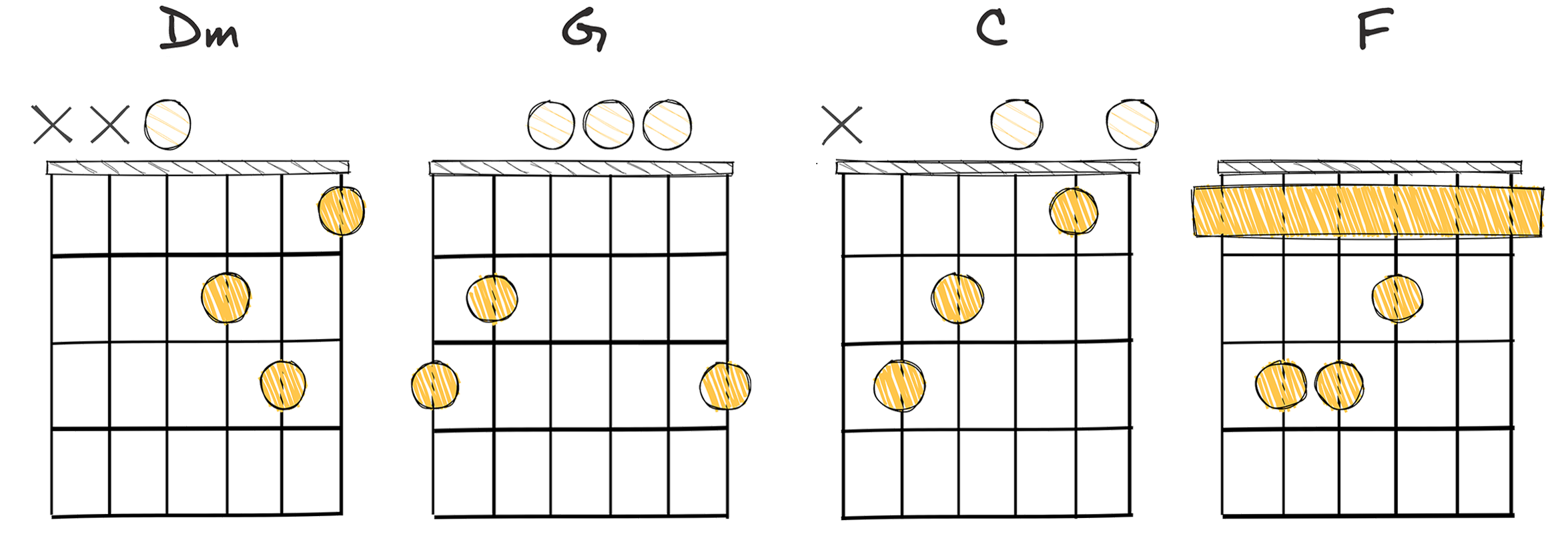
As we delve deeper into lo-fi chord progressions, ii-V-I-IV, or the 2-5-1-4 progression, comes up as a notable aspect.
This particular chord progression has a pristine place in many melodies, including the popular music genre, and it’s also a favourite among producers for building beats.
While the unusual sound of the ii-V-I-IV progression is partly due to its mid-level complexity, its flexibility is also a contributing factor, making it a preferred choice for creating diverse soundscapes.
It’s flexibility allows it to build an evocative and enthralling lo-fi soundscape with a smooth, flowing rhythm.
Moreover, its popularity transcends lo-fi, making appearances in various music genres, highlighting its yield in creating alluring melodies.
The basis of this chord progression is the resolution from the V chord (the dominant) to the I chord (the tonic), which creates the sense of a musical phrase coming to a close.
Adding the iv at the end further extends the phrase, giving even more freedom for musical interpretation and exploration.
The effective application of the progression in the song adds dynamism and character to the mellifluous sequence of sounds.
Its underlying rhythm is, indeed, a beautiful showcase of the progression’s flexibility and ability to adapt to a wide range of musical styles.
As previously mentioned, the Dm – G – C – F chords in the key of C major, are an illustrative embodiment of this progression in the domain of pop music.
Understanding its application and potential can add a new depth to any producer’s musical repertoire.
While the mastery of the ii-V-I-IV progression might require a certain level of musical knowledge and competence, it’s an investment worth making.
Indeed, delving into its history and intricacies can open up new realms of creative possibilities for music producers and composers alike.
I-IV-vi-V (1-4-6-5)
A melancholic, nostalgic tone ideal for atmospheric lo-fi beats.
The I-IV-vi-V chord progression is a basic and popular sequencing in music production, renowned for its melancholic and reflective ambiance. It is perfect for producing Lo-Fi beats, characterized by its simplistic, vintage sounds coupled with complex emotional depth.
- Difficulty: Easy
- Example: G – C – Em – D (Key of G Major)
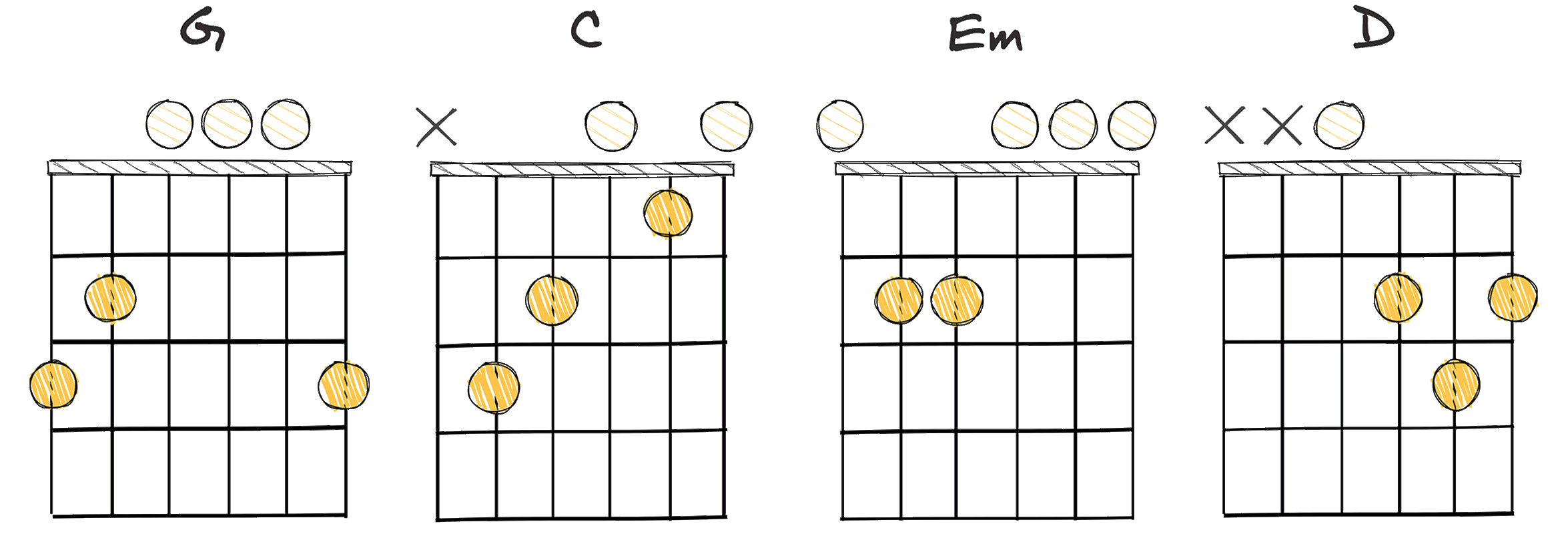
The I-IV-vi-V (1-4-6-5) chord progression is a popular sequence widely used in the world of Lo-Fi music production.
This progression is considered easy to play, making it an excellent starting point for budding Lo-Fi music producers.
Its simplicity lends itself well to the minimalist soundscapes that define the Lo-Fi genre.
This statement underscores the progression’s adaptability to the Lo-Fi style.
The 1-4-6-5 progression’s easy execution allows producers to concentrate on crafting the characteristic chill vibes of the genre.
In addition, the linear flow of the progression adds a sense of continuity and comforting predictability to a track
The I-IV-vi-V (‘one-four-six-five’) progression dates as far back as classical periods and has stood the test of time, making it a staple in modern music genres, including Lo-Fi beats.
Musically, it’s based on the diatonic scale which revolves around the ‘tonic’ or ‘home’ chord (I) and its main dominant (V), subdominant (IV), and relative minor (vi) chords.
During any given progression, the chords played are G – C – Em – D, in the key of G major.
Applying the I-IV-vi-V progression within a Lo-Fi context can yield quite a different effect – a soothing and laid-back auditory experience.
This quote highlights the uniqueness of the 1-4-6-5 progression in the realm of Lo-Fi production.
Despite its application in other genres, the progression retains a distinctive sound when used in Lo-Fi music.
And this is the distinguishing feature of the I-IV-vi-V chord progression.
It’s simple, adaptable, and suitable for a range of genres, from pop tunes to relaxed Lo-Fi beats.
I-IV-vii°-iii (1-4-7-3)
An unconventional, emotionally stirring progression ideal for chill lo-fi beats.
This I-IV-vii°-iii progression creates a unique, relaxed vibe often found in Lo-Fi music, making it perfect for beatmakers aiming for that sound. The progression takes on a melancholic, yet soothing mood, often associated with nostalgia, which is an essential component of the Lo-Fi genre.
- Difficulty: Intermediate
- Example: D – G – C#dim – F#m (Key of D Major)
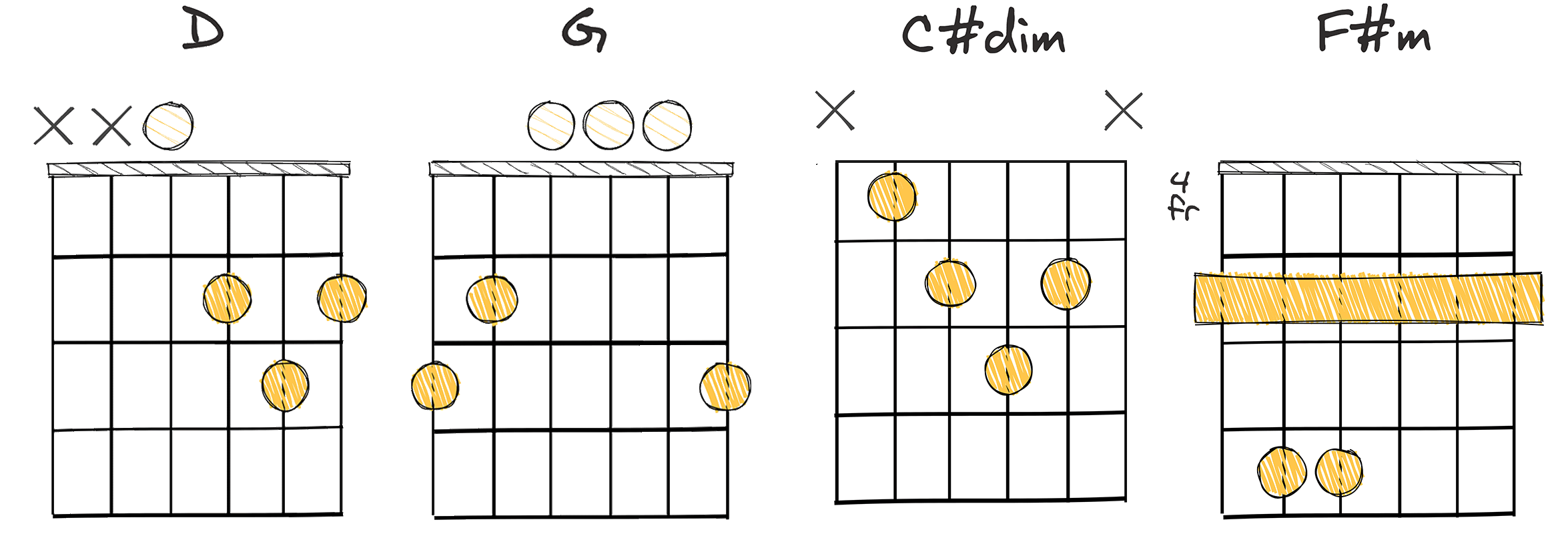
In the world of beat production, chord progressions carry significant weight, serving as the backbone of the music.
The progression I-IV-vii°-iii which translates to 1-4-7-3 in Arabic numerals, takes an interesting place in this realm, particularly when looking at the domain of Lo-Fi music.
This rather intermediate progression has a unique feel to it, and it has been used successfully in many remarkable tracks.
Comprehending the essence of this progression and effectively implementing it in beats, could potentially elevate the overall feel of the music.
The I-IV-vii°-iii incarnation originates from the D Major key where the exact chords would be D – G – C#dim – F#m.
This is definitely important to keep in mind as it strengths the understanding of this progression and how it joins together with similar chordal movements.
It is critical to highlight that this is more than a simple front-to-back chordal movement – it’s a roomy progression with lots of melodic possibilities and opens wide room for creativity.
While this progression is intermediate in terms of playability, it’s rich in potential and can pack a real punch in the right context.
Furthermore, this progression can be inverted, mutated, or otherwise warped to fit various genres and styles while still retaining its essence.
Just imagining the number of musical ideas that are waiting to be discovered in this progression is truly intriguing.
The depth and richness of this progression make it a rewarding choice if you’re looking to bring a certain dynamic nature to your beats.
By studying the nature and use of this chord progression, you can add a new layer of complexity and interest to your music that can help set your work apart.
It pays to investigate and explore a host of chord progressions like I-IV-vii°-iii to truly unlock the potential of your beats and musical abilities.
ii-vi-IV-I (2-6-4-1)
Use this nostalgic progression for a pleasingly melancholic lo-fi feel.
The ii-vi-IV-I chord progression is a popular choice in the lo-fi genre, known for its dreamy, nostalgic, and emotive quality. As a variation of the traditional “four-chord” progression, it allows for a diverse range of mood and tone, offering producers a creative foundation for crafting beats.
- Difficulty: Easy
- Example: Em – Bm – G – D (Key of D major)
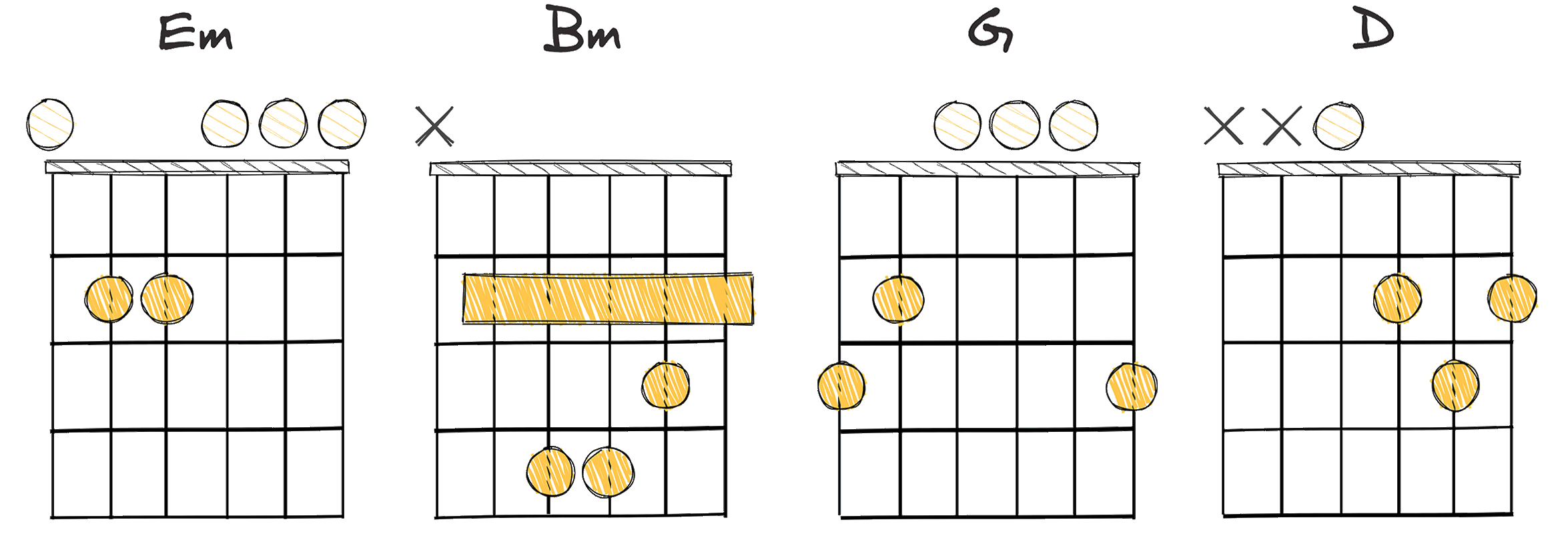
The ii-vi-IV-I (2-6-4-1) chord progression is one of great interest in the realm of lo-fi beat-making.
This progression, though seemingly complex, is actually quite easy to play, making it a fantastic choice for producers at all skill levels.
The key factor behind the ease of play lies in its nature of being a four-chord progression, allowing for an excellent balance between melodic variety and rhythmic simplicity.
Historically, the ii-vi-IV-I progression has roots in classical music but has found its way into many modern and contemporary genres, including pop, rock, and of course, lo-fi beats.
In essence, the II-vi-IV-I chord progression showcases an appealing blend of tension and release which makes it a popular choice for many music producers.
This particular blend is what gives this progression its distinctive sound.
The initial tension created by the ii-vi transition is effectively released by the subsequent IV-I resolving.
It’s worth noting that not all songs will explicitly follow the ii-vi-IV-I progression throughout.
Often, variations and substitutions can occur, adding unique flavor to the melody.
Whether you’re a budding producer or a seasoned veteran, the II-vi-IV-I progression is a valuable tool in the creation of engaging and emotionally evocative lo-fi beats.
In the realm of lo-fi beats, where mood and atmosphere take precedence, the II-vi-IV-I progression’s blend of rhythm and melody can help create a soundscape that resonates with listeners on a deeply emotional level.
As you venture deeper into music production, feel free to experiment with the II-vi-IV-I progression.
Remember, creativity and exploration are at the heart of great music making.
I-vi-ii-V (1-6-2-5)
A foundational, smooth-looping pattern, perfect for laid back Lo-Fi beats.
The I-vi-ii-V chord progression is a classic sequence primarily used in jazz music due to its rich, deep sound. Known for creating a smooth harmonic movement, this progression is a fantastic tool for producers looking to infuse a chill, lo-fi vibe into their beats.
- Difficulty: Easy
- Example: C – Am – Dm – G (Key of C major)
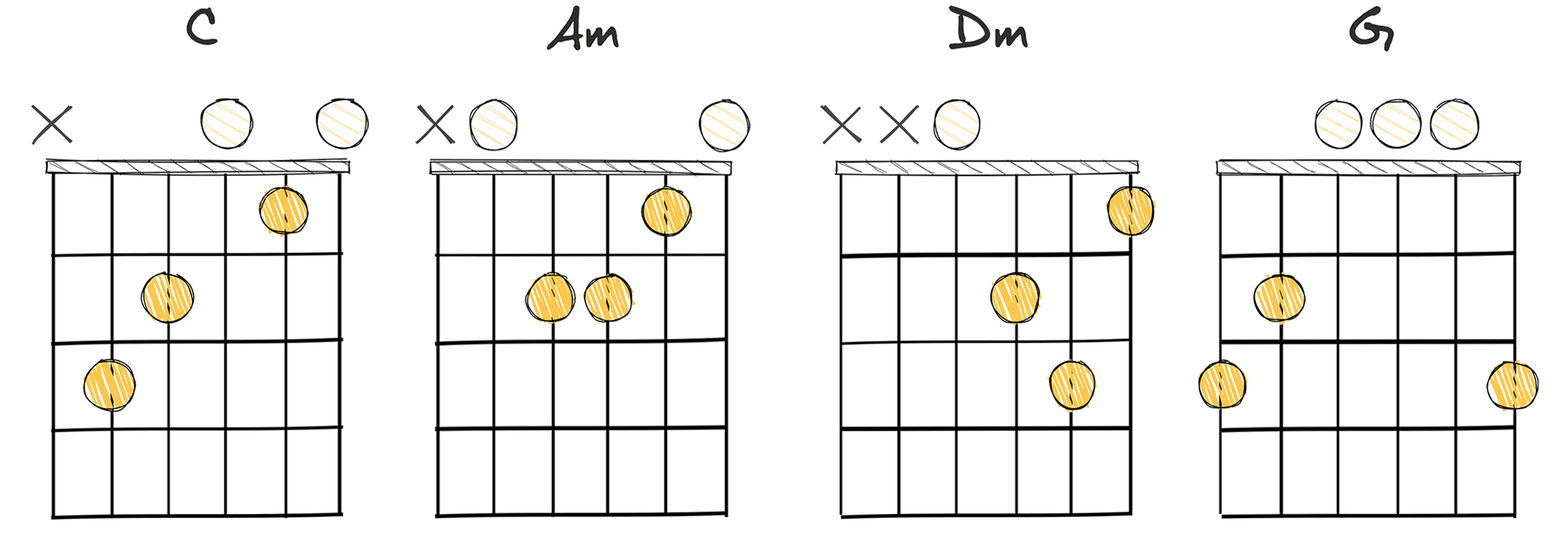
Understanding common chord progressions in Lo-Fi music production is essential for producers who want to create compelling and memorable beats.
The I-vi-ii-V progression (also known as 1-6-2-5), is particularly prevalent, both in classical compositions and contemporary productions.
The history behind this progression is infested with numerous adaptations from different music genres, adding its particular flavor to a variety of tracks.
The I-vi-ii-V progression has been effectively employed in genres spanning from jazz to pop, contributing to the unique and captivating sound of many iconic tunes.
For a lo-fi artist looking to create a track that has a classic, nostalgic feel, trying the I-vi-ii-V progression could lead to some interesting results.
In the key of C major, this progression would translate into the chords C – Am – Dm – G, which offer a lot of flexibility for innovation and experimentation.
From a technical standpoint, the I-vi-ii-V progression is easy to play, which is one of the reasons why many starting musicians resort to it in their compositions.
The relatively simple hand movements required for this progression make it a favorite among beginners, yet its potential for complexity ensures that it also offers great depth for more experienced musicians.
The I-vi-ii-V progression is a versatile tool that can add a good level of dynamic and harmonic variance to your music, so is a staple for any music producer to master.
Remember, while the technical aspects of a chord progression are crucial, the most important factor in music production is creativity and originality.
The use of this progression is not limited to any specific musical genre or style, so it stands as an invitation for you, as a producer, to explore its possibilities in the context of your own musical narrative.
Even if this chord progression is common, the way you manipulate it and introduce it into your beat can result in something fresh and unique.
I-ii-vii°-IV (1-2-7-4)
Delivers a unique blend of complexity and appeal, embodying an engaging emotional depth in pop music..
The I-ii-vii°-IV progression in C major, weaving C – Dm – Bdim – F, provides an intriguing musical narrative. Its blend of major, minor, and diminished chords crafts a complex yet appealing sound, making it an attractive choice for creating emotional depth in pop music.
- Difficulty: Easy
- Example: C – Dm – Bdim – F (Key of C major)
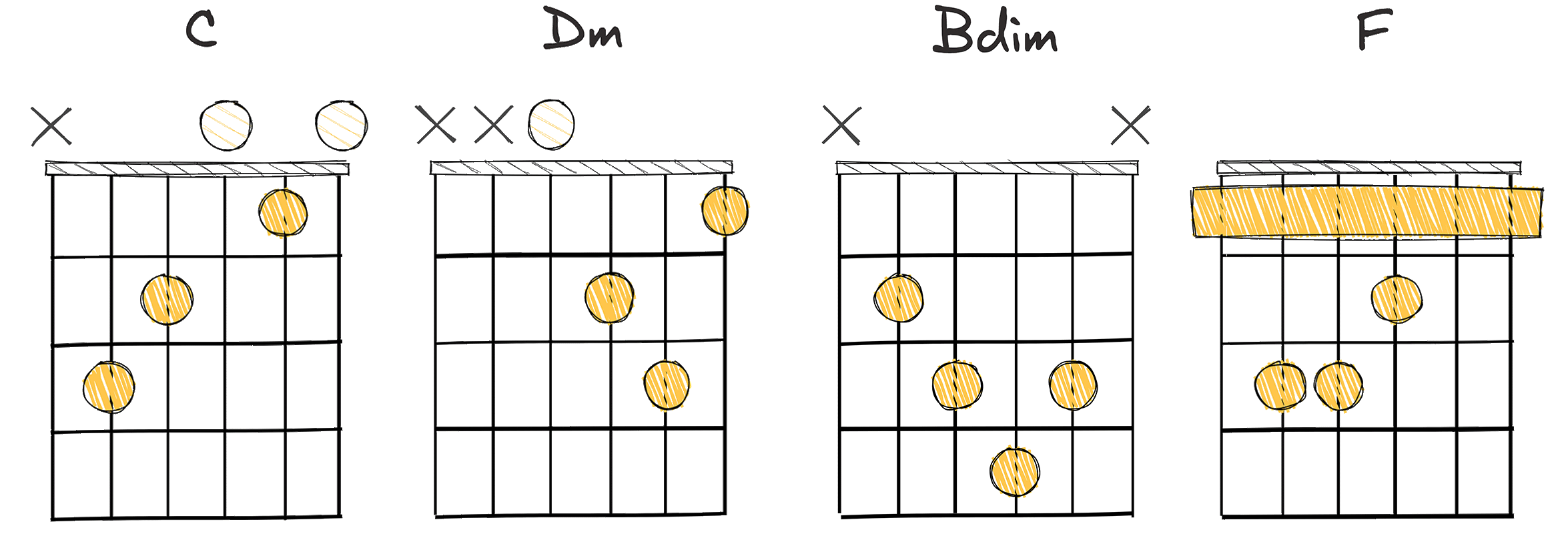
Delving into the musical tapestry, one progression that stands out is the I-ii-vii°-IV (1-2-7-4), with a specific example in the key of C major being C – Dm – Bdim – F.
Unlike more conventional patterns, this progression offers a dynamic and engaging sound, making it a powerful tool in the realm of pop music.
The I-ii-vii°-IV progression, although less common, carries a sense of freshness, while maintaining a connection to the musical traditions that have shaped Western music.
This chord sequence may initially present a challenge for some beginners, but its complexity offers an opportunity to grow as a musician.
The inclusion of a diminished chord (vii°) in this progression adds a touch of tension and unpredictability that can be harnessed to create a striking emotional effect.
Whether it’s the thrill of anticipation or a melancholic yearning, the I-ii-vii°-IV progression can convey an array of emotions, giving composers and songwriters a broad palette to work with.
Though not as widespread as some other progressions, its application in pop music has been marked by innovation and individuality.
This isn’t just a sequence to play; it’s a journey to explore, filled with potential for creating unique soundscapes within the pop genre.
For example, employing different strumming patterns or playing techniques to these chords can bring them to life in unexpected ways, infusing the music with character and flair.
The I-ii-vii°-IV progression isn’t just another chord sequence; it’s a bold statement, a musical expression that invites exploration and experimentation.
Its presence in pop music speaks to its adaptability and ability to resonate with listeners, providing a solid foundation while encouraging creative freedom.
Though it might seem unconventional, the potential of the I-ii-vii°-IV progression is vast. Embracing it could be the key to crafting pop songs with a unique signature and emotional depth.
vi-IV-I-V (6-4-1-5)
An emotive, melancholy progression perfect for setting a lo-fi mood.
The vi-IV-I-V chord progression is a popular musical structure used frequently in lo-fi beats due to its smooth, laid-back vibe. This progression, which moves from the sixth to the fourth to the first and then the fifth chord within the scale, offers a melting pot of emotions and is easy to loop, making it ideal for beatmakers and producers aiming for a chill, downtempo sound.
- Difficulty: Easy
- Example: Bm – G – D – A (Key of D major)
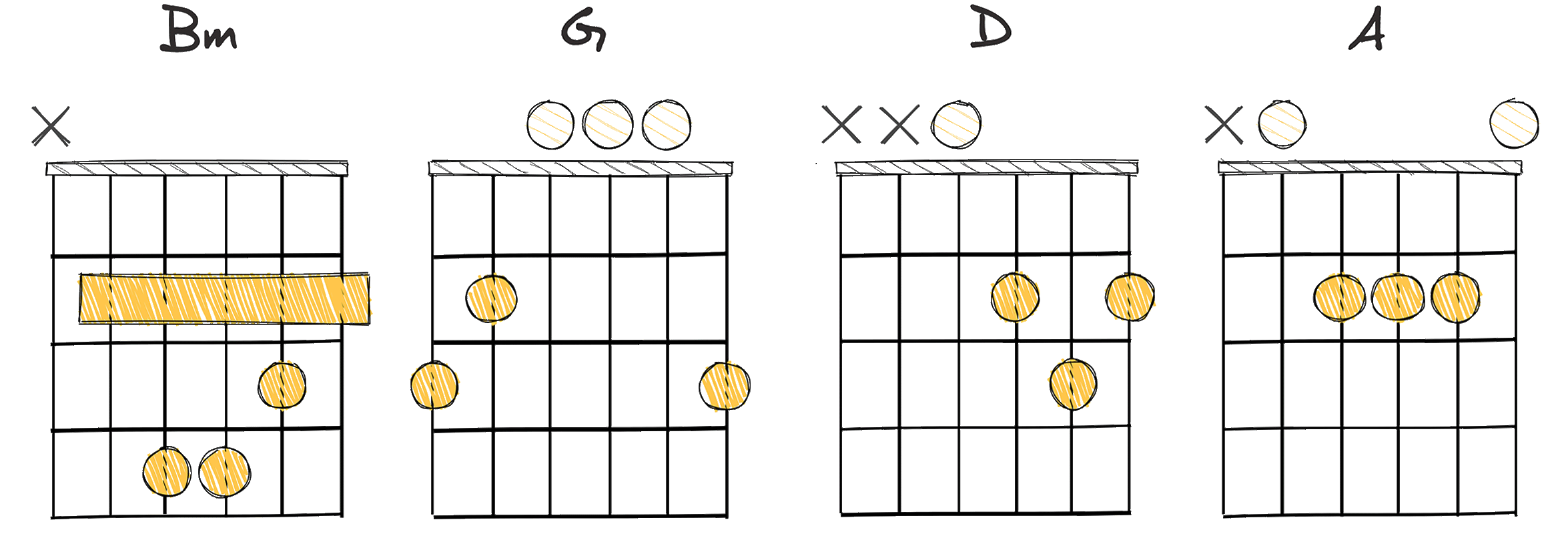
The vi-IV-I-V (6-4-1-5) chord progression is notably one of the most popular progressions used in the realm of music production, particularly within the lo-fi genre.
Its history can be traced back to classical compositions, but it’s more renowned for its prevalence in modern pop and rock music.
While it might seem like a tricky progression to grapple with, in reality, it’s fairly simple to comprehend, even for those new to music production or playing an instrument.
The vi-IV-I-V progression begins with a chord on the sixth degree of the scale, typically a minor chord, which transitions into a major chord on the fourth degree.
This is followed with a seamless switch to the first degree chord, another major, which finally moves into a major or seven chord on the fifth degree.
For example, the vi-IV-I-V sequence in the key of D major would be: Bm – G – D – A.
This example shows how the progression offers an appealing combination of emotional depth and resolve, blending the melancholic tones of minor chords with the uplifting feel of major chords.
The result is a versatile chord progression that can add a sense of narrative depth and range of emotion to your beats, proving ideal for lo-fi production.
As a producer, incorporating vi-IV-I-V into your beats can open the doors to a world of sonic possibilities.
In the lo-fi genre, this progression might typically be used with down-tempo beats and retro synth sounds to cultivate a nostalgic, tranquil, and introspective mood.
This versatile progression offers unlimited scope for musical exploration and emotional expression, thus making it a valuable asset for any lo-fi producer.
It is, undoubtedly, a must-know, especially for beginners in the beat-making scene.
ii-IV-I-V (2-4-1-5)
A mellow, nostalgic progression perfect for creating dreamy beats.
This ii-IV-I-V chord progression, also known as the 2-4-1-5 pattern, often features in Lo-Fi music, providing a distinctive laid-back and nostalgic sound. It is particularly popular among producers for creating relaxed, mellow beats perfect for the genre.
- Difficulty: Easy
- Example: Em – G – D – A (Key of D Major)
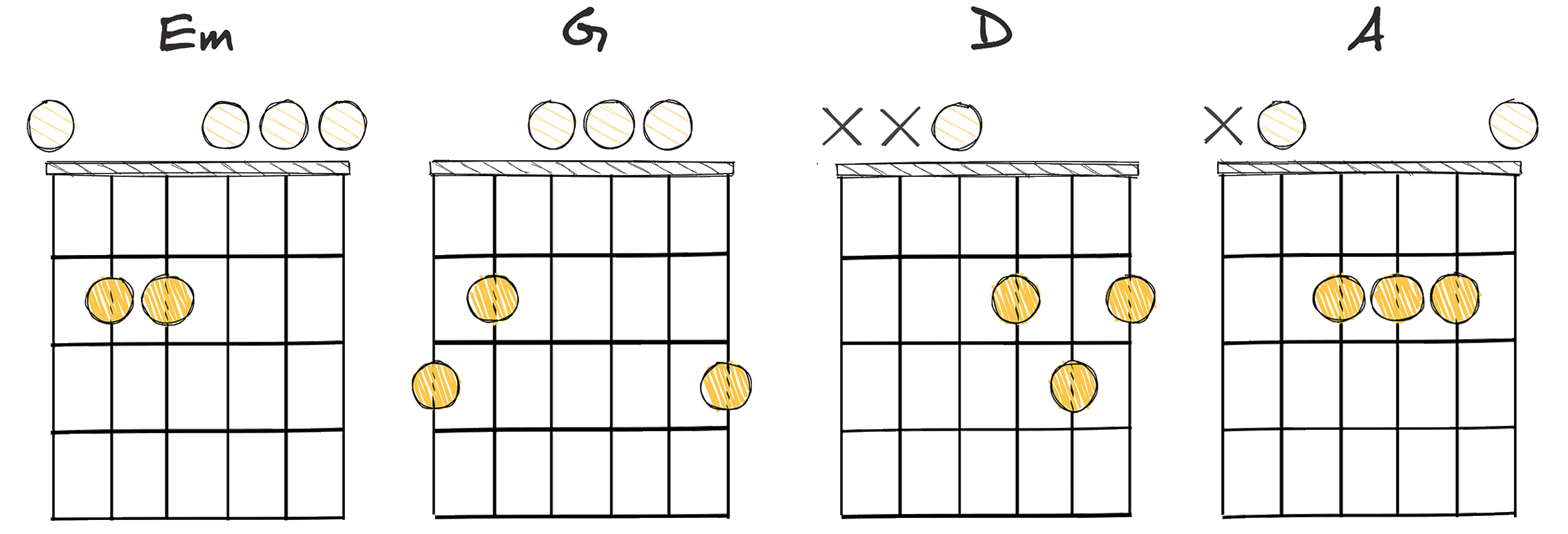
In the creation of lo-fi beats, chord progressions often constitute a fundamental part of the song’s structure.
Of particular significance in this genre is the ii-IV-I-V progression (or 2-4-1-5 in numeric notation).
Historically, this chord progression has enabled producers to construct a relaxed, tonally stable atmosphere that perfectly complements the low fidelity aesthetics of the lo-fi genre.
Whether you are a beginner or a professional producer, the simplicity of this chord progression makes it particularly easy to learn and execute, regardless of your level of technical skill.
The simplicity of these four chords streamlines the creation process, letting artists direct their attention towards experimenting with textural aspects and sound manipulation.
That is not to say, however, that the ii-IV-I-V progression is lacking in musical depth.
On the contrary, the progression’s musical depth is testified by the myriad of hit songs that have used this formula.
Infusing a sense of nostalgia to the listener, this progression, when used appropriately, has the ability to dig deep and touch emotional nerve-endings, making it a favourite amongst producers in the lo-fi genre.
It’s not rare to find this progression used in conjunction with an inversion or alteration, allowing for greater harmonic diversity.
It is crucial for producers to remember that despite the ease of this progression, unique and clever instrument arrangements are still important elements that can bring out the best in the ii-IV-I-V chord progression.
It’s the indubitable popularity and versatility of the ii-IV-I-V progression that has allowed it to continue to be a go-to for producers looking to effortlessly evoke a warm and vintage aura for their tracks.
vi-ii-V-I (6-2-5-1)
A smooth, versatile, and jazz-influenced staple in lo-fi beats.
The vi-ii-V-I chord progression, common in jazz and used often in lo-fi hip hop, offers a smooth yet melancholic transition that often forms the backbone of many lo-fi tracks. Its soulful tones and relaxing vibe provide an inspirational basis for beat producers to create lush, atmospheric soundscapes.
- Difficulty: Easy
- Example: F#m – Bm – E – A (Key of A major)
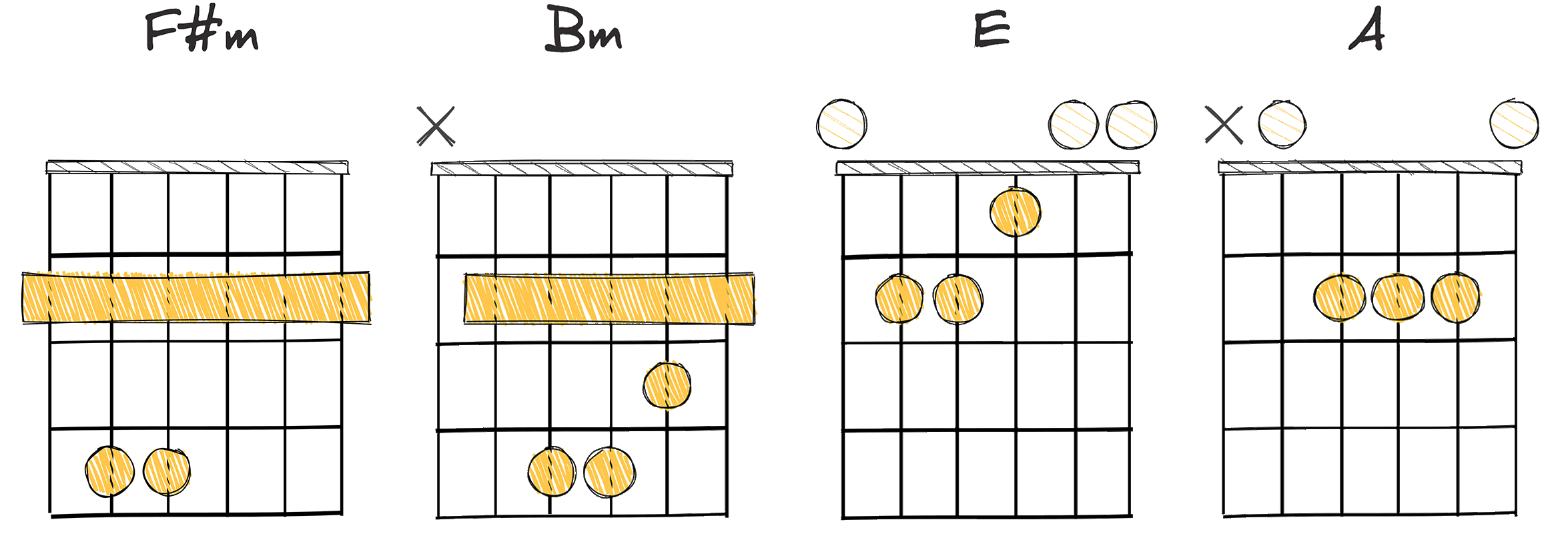
In examining the chord progression vi-ii-V-I (6-2-5-1), there’s an undeniable connection to a certain genre and stylistic approach in music.
Lo-Fi, being a genre that thrives in simplicity and rawness, finds a perfect home with this progression.
This chord progression holds an interesting compactness that caters to an easy playability on a range of instruments.
It’s essentially a reverse cycle of fourths, which is an inherently strong progression in terms of voice leading.
The vi-ii-V-I (6-2-5-1) progression is easy to play because the chord tones often remain the same, but the bass note changes.
This makes it easy for fingers to find the next chord making it a favourite for musicians, especially producers.
Distinct from other progressions, the vi-ii-V-I progression has a tendency to convey feelings of nostalgia and profound emotion when used appropriately, contributing to the mood that lo-fi music strives to create.
This notably harmonious progression gives the music a unique colour and depth, rendering it ideal for the creation of Lo-Fi beats.
Not only does it offer a warm and rich sound, but also it allows the intertwining of multiple sonic textures which is a significant principle in Lo-Fi music production.
When we look back at the history of this progression, it’s evident that its usage is widespread across various facets of music.
The history of this progression indicates its roots in the classical period.
However, it became more universally accepted in the Jazz age, largely due to the impressionistic touch it imbibes.
This progression found its way into pop music and finally into lo-fi genres because of its unique blend of simplicity and emotion.
Unfolding into modern times, this progression has been used effectively to create hits.
Moving away from pop and delving into Lo-Fi, this progression assists in eliciting a serene, contemplative environment.
This is why it’s widely used in beats that aim to create a certain introspection for the listener.
Even without lyrics or melody, the vi-ii-V-I progression carries a story, transitioning from tension to resolution, from consonance to dissonance, then back to consonance.
Assuming the supposed key is A Major, the ‘F#m – Bm – E – A‘ chord application of this progression into an actual musical piece can bring about an inviting and compelling texture that enhances the listener’s experience.
The variance in the rhythm and pacing of these chords can instill the unique vibe lo-fi music aims to achieve.
Indeed, a chord progression like the vi-ii-V-I is a valuable tool in a lo-fi producer’s arsenal.
Its ability to encapsulate the essence of the genre with just a simple chord sequence is truly worth embracing.
IV-I-vi-vi (4-1-6-6)
Harmonically rich and gentle, ideal for introspective Lo-Fi moods.
This chord progression, IV-I-vi-vi, is a harmonious sequence that’s popular in Lo-fi tracks, effectively invoking a relaxed, vintage vibe. Offering a rich sound experience, these chords shift from the fourth to the first to the sixth (repeated twice), seamlessly creating a loop that works perfectly for Lo-fi beats.
- Difficulty: Easy
- Example: Bb – F – Dm – Dm (Key of F major)
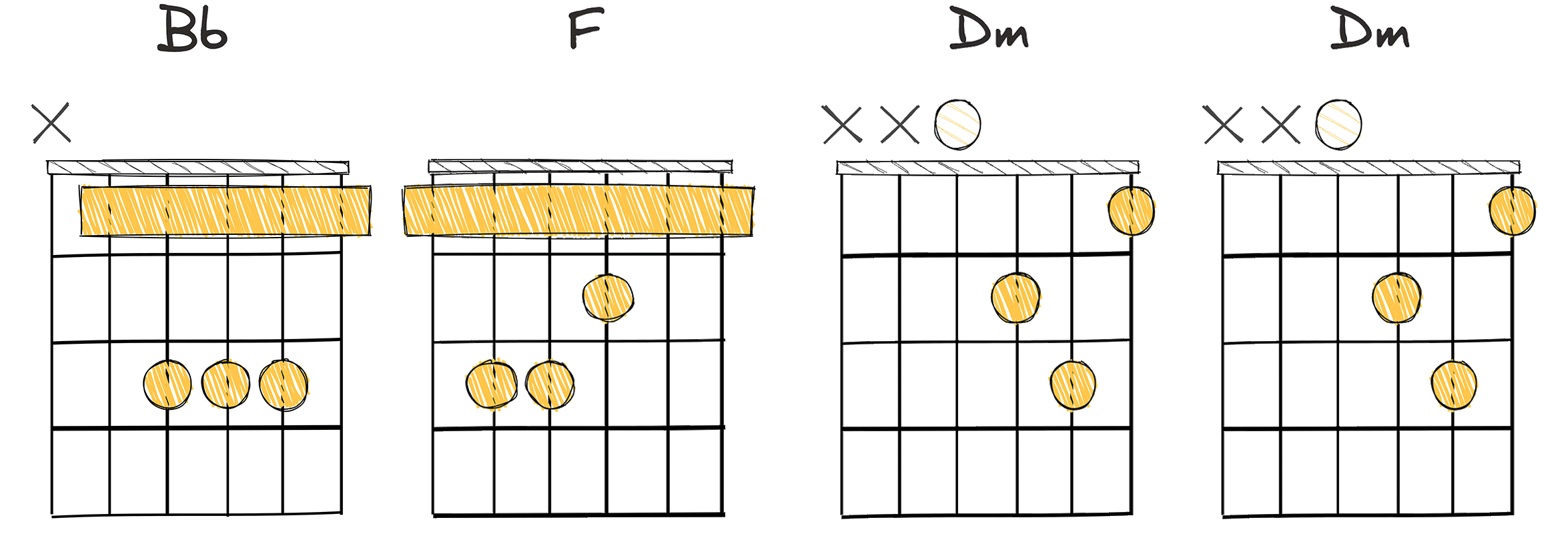
The IV-I-vi-vi (4-1-6-6) chord progression is a fundamental component within the realm of music theory, particularly in lo-fi music production.
It’s an enticing chord progression for lo-fi producers looking to craft unique, chill beats — the kind of laid-back grooves that have come to characterize this genre.
One reason this progression is popular is due to its versatility; it can be moulded to fit various musical styles.
That being said, IV-I-vi-vi (4-1-6-6) has an inherent melodious nature, generating a smooth, easy-to-identify resolution for the listener that typifies the lo-fi production aesthetic.
This inherent melodious nature of the progression often evokes an emotional response — an essential element that makes the lo-fi beats more intimate.
This chord progression is also a common way to transition from one section to the next within a song.
The IV-I-vi-vi (4-1-6-6) chord progression holds a storied place in the annals of music history.
Producers have used it seamlessly to evoke a specific emotional feel, and its presence is felt across multiple songs and genres.
In the corresponding key of F major, the chords would be Bb – F – Dm – Dm, which are the building blocks of many a soul-stirring lo-fi beat.
From a technical standpoint, the IV-I-vi-vi progression is an extremely straightforward one to play, making it accessible to producers of varying skill levels.
Even without prior music theory knowledge, a producer would find it easy to experiment with and incorporate into their beats.
Furthermore, this progression encourages innovation, because while the formula remains unchanged, the variety of sounds and rhythms you can apply to it is virtually endless.
The Bottom Line
Examining the various chord progressions as listed, it’s evident that these music sequences play a significant role in solidifying the harmonic structure of a music piece, providing a solid foundation for melodies, and creating tonal variety.
They are not only the backbone of a song but also serve the purpose of building emotional intensity and release.
Each one offers a unique emotional journey for the listener, from the classic II-V-I progression well-loved in jazz, to the saccharine-sweet pop of I-V-vi-IV and the melancholic touch of i-iv-VII-III.
To put it plainly, chord progressions are the musical equivalent of a story’s plot, taking listeners through a heartbreaking tragedy, uplifting journey, or anything in between.
They add depth and sophistication to music, making them an integral part of songwriting and composition.
In love with guitars, and gear; expert in all things music! Been writing about guitars for about 5 years and counting. Born in the ’90s. Alma Mater: University of Havana. Always curious, trying to understand the world. #TeamFender

